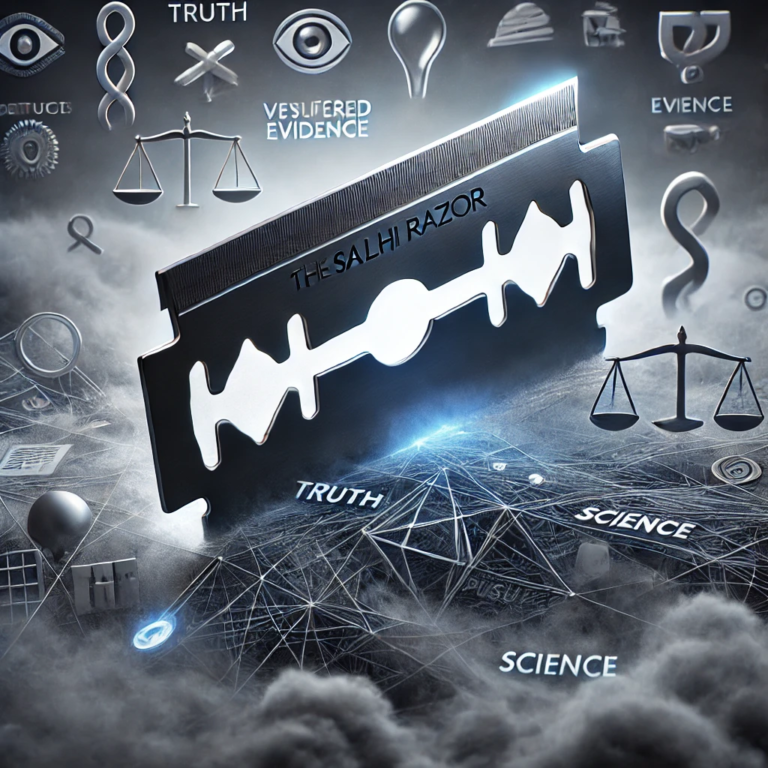Abstract
Conspiracy theories have significant societal, political, and cultural implications, yet they are not all of equal validity. Some are based on verifiable facts, while others are completely unfounded. This paper introduces the Salhi Razor, a structured methodology for distinguishing real conspiracies from pseudoconspiracies. It integrates critical thinking, ethical reasoning, and scientific methodology to form a rigorous framework that assesses conspiracy theories. The paper provides a comprehensive examination of the Salhi Razor’s principles, applications, and ethical implications, offering a novel tool for academics, journalists, and policymakers.
Introduction
In recent decades, conspiracy theories have flourished, facilitated by digital media, mistrust of institutions, and growing political polarization. While some conspiracies are grounded in verifiable facts, others are based on misunderstandings or deliberate deception. Consequently, distinguishing between legitimate conspiracies and pseudoconspiracies is essential for maintaining societal trust and intellectual rigor. This paper proposes the Salhi Razor, a method designed to rigorously evaluate conspiracy theories by applying a set of clear, objective criteria rooted in logic, ethics, and scientific reasoning.
Definition of Conspiracy Theories
A conspiracy theory, in its most basic form, is an explanation of events or circumstances that attributes them to secret, malevolent groups. These explanations typically stand in contrast to official accounts, suggesting hidden motives or covert actions. While some conspiracy theories have been proven to be true, such as the Watergate scandal or the FBI’s COINTELPRO operation, many others are unsupported by evidence and are thus classified as pseudoconspiracies (Goertzel, 1994). This distinction is important because it allows for a more nuanced evaluation of conspiracy theories, distinguishing between fact-based inquiries and speculative narratives (Keeley, 1999).
The Salhi Razor: Key Principles
The Salhi Razor proposes five core principles that a valid conspiracy must satisfy to be considered plausible. These principles are grounded in logic, evidence, and ethical reasoning, providing a framework for evaluating the veracity of conspiracy theories.
1. The Kernel of Truth Principle
Real conspiracies often begin with a kernel of truth—an event or fact that is obscured, manipulated, or misrepresented for ulterior motives. The existence of such a kernel is critical because it serves as the starting point for further speculation and investigation. However, the kernel of truth does not alone substantiate the entirety of the conspiracy. For example, the NSA’s surveillance programs were initially dismissed as conspiracy theories but were later substantiated by Edward Snowden’s revelations (Sunstein & Vermeule, 2009). This principle emphasizes that real conspiracies must have a factual basis from which more complex narratives emerge.
2. Strategic Intelligence
Real conspiracies are often strategically planned, requiring coordination and intellectual foresight. Unlike pseudoconspiracies, which are typically chaotic, internally contradicting or irrational, genuine conspiracies involve actors with clear objectives and a well-thought-out plan. This element of intelligence distinguishes real conspiracies from baseless claims, which may lack the organizational coherence required for successful execution (Harambam, 2020). For example, the Watergate scandal involved multiple levels of government officials and sophisticated methods of covering up illicit activities, demonstrating the strategic intelligence behind it.
3. Malevolent Intent
Another hallmark of a real conspiracy is malevolent intent. The actions of the conspirators are driven by a desire to achieve personal, political, or financial gain at the expense of others. This principle ties directly into ethical reasoning, as it implies that real conspiracies are not simply misunderstandings or misinterpretations but deliberate, harmful actions. The Tobacco industry’s suppression of research linking smoking to cancer, for instance, was a conspiracy based on malevolent intent to protect profits at the cost of public health (Uscinski & Parent, 2014).
4. Feasibility
A conspiracy must be feasible within the context of known technology and scientific knowledge. This principle ensures that conspiracies are not based on fantastical elements or supernatural claims. For instance, the Moon landing conspiracy theory, which suggests that the United States faked the Apollo missions, fails the feasibility test, as it disregards the extensive evidence from multiple scientific fields supporting the authenticity of the landings (Popper, 1963). Real conspiracies, by contrast, involve actions that are plausible given the technological and societal conditions of the time.
5. Incomplete Information
The presence of incomplete or missing information is a key characteristic of conspiracies. Real conspiracies typically involve a suppression or manipulation of data to maintain secrecy and prevent discovery. The Salhi Razor suggests that gaps in knowledge or evidence should prompt further investigation, rather than assuming that these gaps automatically support a conspiracy theory. However, these gaps alone are not sufficient to validate a theory; they must be coupled with credible evidence and logical analysis (Prooijen & Douglas, 2018).
Ethical Considerations in Applying the Salhi Razor
1. Risks of Mislabeling and Marginalization
A critical ethical issue in applying the Salhi Razor is the risk of mislabeling legitimate concerns as pseudoconspiracies. Certain groups, particularly marginalized communities, may use conspiracy theories to explain systemic oppression or injustice. For example, minority communities may be skeptical of government actions due to historical injustices, such as the Tuskegee Experiment. Labeling such skepticism as mere paranoia could perpetuate harm by dismissing real concerns (Sunstein & Vermeule, 2009). Ethical application of the Salhi Razor requires sensitivity to historical context and an understanding that legitimate grievances can sometimes manifest in conspiratorial narratives.
2. Ethical Responsibility in Application
The application of the Salhi Razor must be unbiased and transparent. Analysts must be aware of their own biases and ensure that the criteria are applied consistently. This is especially important in fields like journalism and academia, where the stakes of misclassification are high. For instance, journalists using the Salhi Razor must distinguish between harmful pseudoconspiracies (e.g., anti-vaccine claims) and those that may have a factual basis, such as whistleblower accounts (Wood, Douglas, & Sutton, 2012). This distinction is crucial for maintaining intellectual integrity and ensuring that public trust is not unduly undermined.
3. Accountability and Public Trust
The Salhi Razor can be an effective tool for holding individuals or organizations accountable for their actions. By identifying and exposing real conspiracies, it can help restore public trust in institutions and prevent further harm. For instance, investigative journalism based on the principles of the Salhi Razor can uncover corporate malfeasance or government misconduct, as demonstrated by the release of the Pentagon Papers (Harambam, 2020). The ethical application of the methodology promotes transparency and ensures that the public is informed about the true nature of significant events.
Broader Applications of the Salhi Razor
1. Media and Journalism
In the media, conspiracy theories often spread rapidly, particularly on social media platforms. Journalists, as gatekeepers of information, have a responsibility to evaluate the validity of conspiracy claims. The Salhi Razor can help journalists assess whether a theory is based on verifiable evidence or simply speculative. By adhering to the criteria outlined in the Salhi Razor, journalists can filter misinformation and ensure that the public receives accurate, well-reasoned reports (Uscinski & Parent, 2014).
2. Digital Misinformation
With the rise of digital media, misinformation and pseudoconspiracy theories have become more prevalent. Social media platforms, for instance, are often rife with baseless claims about topics such as vaccines or political elections. The Salhi Razor offers a tool for moderators to assess and debunk harmful misinformation, helping to curb the spread of unfounded conspiracy theories. Integrating the Salhi Razor into content moderation policies could significantly reduce the visibility of pseudoconspiracies (Prooijen & Douglas, 2018).
3. Education and Critical Thinking
Incorporating the Salhi Razor into educational curricula focused on critical thinking and media literacy can help students develop the skills to evaluate conspiracy theories independently. By understanding the logical structure behind real conspiracies and pseudoconspiracies, students can become more discerning consumers of information and more active participants in democratic discourse (Keeley, 1999). This educational application can foster a generation that is better equipped to navigate the complex information landscape of the 21st century.
4. Policy and Governance
Policymakers often face the challenge of responding to public concern about potential conspiracies, particularly during crises such as pandemics or political upheaval. The Salhi Razor can aid in distinguishing between legitimate concerns and harmful, baseless claims, ensuring that public health policies or political strategies are based on facts rather than unfounded fears. By using the Salhi Razor, governments can more effectively communicate with the public and address issues without inadvertently promoting pseudoconspiracies (Uscinski & Parent, 2014).
Conclusion
The Salhi Razor provides a novel and comprehensive methodology for distinguishing between real conspiracies and pseudoconspiracies. By adhering to a structured set of principles grounded in logic, ethics, and scientific reasoning, it offers a robust tool for scholars, journalists, and policymakers. Its ethical application can restore public trust, promote accountability, and foster critical thinking in a society increasingly influenced by misinformation. Moving forward, further empirical research will be needed to refine the methodology and test its applicability across a broader range of conspiracy claims.
References
Goertzel, T. (1994). Belief in conspiracy theories. Political Psychology, 15(4), 731–742. https://doi.org/10.2307/3791575
Harambam, J. (2020). The trust-based approach to conspiracy theories: Understanding the role of trust in conspiracy thinking. Social Science Information, 59(2), 212–236. https://doi.org/10.1177/0539018419897959
Keeley, B. L. (1999). Of conspiracy theories. Journal of Philosophy, 96(3), 109–126. https://doi.org/10.2307/2564630
Popper, K. (1963). Conjectures and Refutations: The Growth of Scientific Knowledge. Routledge.
Prooijen, J. W., & Douglas, K. M. (2018). Conspiracy theories as part of history: The role of societal crisis situations. Memory Studies, 11(3), 221–234. https://doi.org/10.1177/1750698018756712
Sunstein, C. R., & Vermeule, A. (2009). Conspiracy theories: Causes and cures. Journal of Political Philosophy, 17(2), 202–227. https://doi.org/10.1111/j.1467-9760.2008.00325.x
Uscinski, J. E., & Parent, J. M. (2014). American Conspiracy Theories. Oxford University Press.
Wood, M. J., Douglas, K. M., & Sutton, R. M. (2012). Dead and alive: Beliefs in contradictory conspiracy theories. Social Psychological and Personality Science, 3(6), 767–773. https://doi.org/10.1177/1948550612439758




